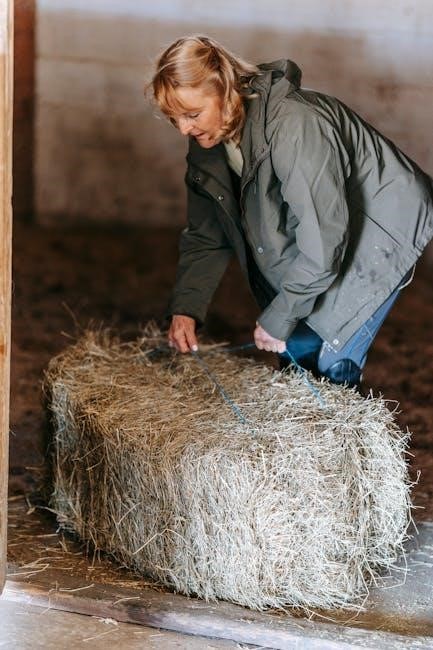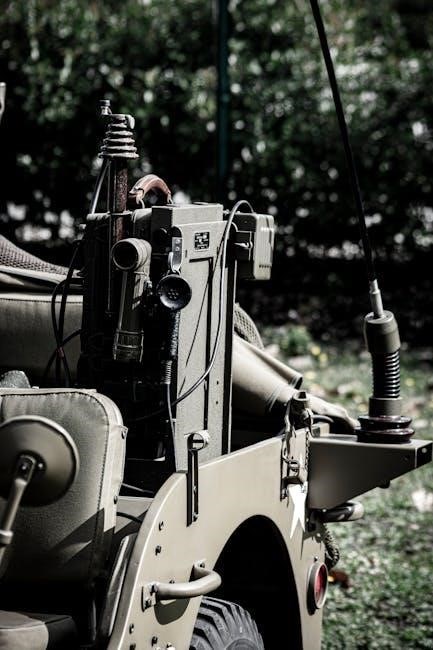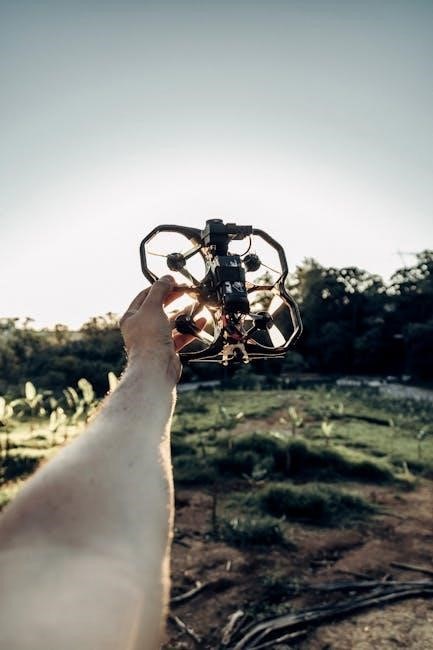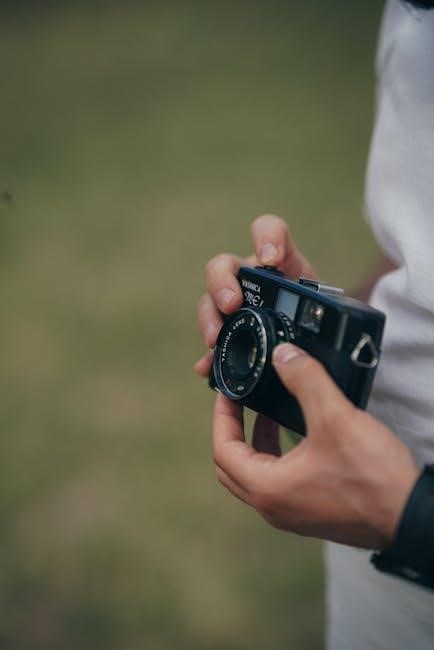Welcome to the NJROTC Cadet Field Manual, a comprehensive guide for cadets to master military drill, ceremonies, uniforms, and leadership skills. This manual is essential for developing discipline and understanding of naval traditions.
1.1 Purpose and Importance of the Manual
The NJROTC Cadet Field Manual serves as a primary reference guide for cadets, detailing procedures for military drill, ceremonies, and uniform regulations. Its purpose is to provide a single-source document for understanding naval traditions, leadership principles, and operational standards. This manual is essential for fostering discipline, professionalism, and accountability among cadets. By adhering to its guidelines, cadets can excel in field meets, inspections, and community events, ensuring a unified and respectful representation of the NJROTC program.

1.2 Overview of the NJROTC Program
The NJROTC program is a four-year curriculum designed to develop leadership, citizenship, and maritime knowledge among high school students. It emphasizes military drill, ceremonies, and uniform standards while fostering teamwork and discipline. Cadets participate in field meets, inspections, and community service, preparing them for future challenges. The program also includes classroom instruction on naval history, traditions, and core values, ensuring a well-rounded understanding of military life and its expectations.
1.3 Structure and Organization of the Manual
The NJROTC Cadet Field Manual is organized into nine main sections, each addressing specific aspects of the program. It begins with an introduction, followed by core subjects like drill, uniforms, leadership, and military history. Practical applications and resources are also included, ensuring a comprehensive understanding. The manual is designed for easy navigation, with clear headings, subheadings, and bullet points to enhance readability. This structure allows cadets to quickly locate information, making it an indispensable tool for training and reference.

Core Subjects Covered in the Manual
The manual covers essential topics such as military drill, uniform regulations, leadership development, and military history. These subjects form the foundation of the NJROTC program.
2.1 Military Drill and Ceremonies
Military drill and ceremonies are fundamental components of the NJROTC program, emphasizing discipline, teamwork, and precision. Cadets learn basic drill commands, formation techniques, and ceremonial protocols, such as flag raising and retirement. These activities foster unity and respect for tradition, preparing cadets for formal events and competitions. The manual provides detailed guidance on proper execution, ensuring cadets master these skills and understand their significance in military culture. Regular practice and adherence to the manual’s instructions are essential for achieving excellence in drill and ceremony performances.
2.2 Uniform Regulations and Grooming Standards
The NJROTC Cadet Field Manual outlines strict uniform regulations and grooming standards to ensure professionalism and unity among cadets. It classifies uniforms into categories such as service, dress, and working attire, detailing proper wear and maintenance. Grooming standards emphasize neatness and adherence to military appearance protocols, including hair length, nail care, and facial hair guidelines. These regulations prepare cadets for inspections and formal events, fostering discipline and pride in their appearance. The manual serves as a guide to ensure all cadets meet these standards consistently.
2.3 Leadership and Command Structure
The NJROTC Cadet Field Manual emphasizes the importance of leadership and command structure, outlining the roles and responsibilities of cadet officers. It provides guidance on effective leadership principles, decision-making, and communication skills. The manual also details the chain of command, ensuring cadets understand their positions within the unit. By fostering teamwork and accountability, the manual prepares cadets to lead confidently in various scenarios, from drills to community service events. This section is crucial for developing future leaders who embody discipline and responsibility.
2.4 Military History and Traditions
The NJROTC Cadet Field Manual explores the rich history of the U.S. Navy and its traditions, providing cadets with a deep understanding of their heritage. It covers key historical events, the evolution of naval ranks, and the significance of customs and courtesies. Cadets learn about the founding of the NJROTC program, its mission, and the importance of upholding naval traditions. This section fosters pride and respect for the naval service, ensuring cadets appreciate the legacy they represent. Understanding history and traditions is vital for building a strong foundation in military culture and values.
Drill and Ceremony Procedures
This section outlines essential procedures for military drills and ceremonies, including basic commands, formations, flag etiquette, and parade protocols. It ensures cadets master these skills with precision and discipline, fostering teamwork and respect for tradition.
3.1 Basic Drill Commands and Movements
Basic drill commands and movements are fundamental to military precision and discipline. Cadets learn to execute commands like “Attention,” “At Ease,” “Right Face,” and “Forward March” with accuracy. These movements, such as the “30-Inch Step” and “Quick Time,” are practiced to ensure unity and coordination. Proper posture, alignment, and rhythm are emphasized to build confidence and teamwork. Mastery of these basics is crucial for more complex drills and ceremonies, reflecting the NJROTC’s commitment to excellence and tradition.
3.2 Formation and Alignment Techniques

Formation and alignment techniques are critical for maintaining unit cohesion and visual precision. Cadets learn to establish intervals, dress lines, and maintain proper spacing. These techniques ensure uniformity in drills and ceremonies. Key elements include understanding the “guide” concept, aligning by the tallest member, and adjusting for proper cover. Mastery of these skills enhances the unit’s professional appearance and demonstrates discipline. Regular practice reinforces these principles, preparing cadets for flawless execution during parades, inspections, and other formal events.
3.3 Flag Ceremonies and Protocol
Flag ceremonies are a cornerstone of military tradition, requiring precision and respect. Cadets learn proper procedures for raising, lowering, and folding the flag. The morning colors ceremony begins with raising the flag, while evening colors involve lowering it. Protocol dictates facing the flag during the national anthem and saluting appropriately. Folding the flag into a triangular shape symbolizes respect and care. These ceremonies honor national heritage and instill patriotism in cadets, ensuring they understand the significance of the flag as a symbol of freedom and unity.
3.4 Parade and Inspection Procedures
Parade and inspection procedures are critical for demonstrating unit cohesion and discipline. Cadets must align precisely in formation, maintaining proper posture and spacing. The commander inspects uniforms, ensuring adherence to grooming and dress standards. During parades, synchronized movements and sharp responses to commands highlight teamwork and training. Inspections evaluate readiness, while parades showcase unit pride and esprit de corps. These events foster accountability and prepare cadets for formal military ceremonies, reinforcing the importance of precision and professionalism in all activities.
Uniform Regulations
Uniform regulations ensure cadets present a professional image, adhering to strict grooming and dress standards. Proper wear, maintenance, and classification of uniforms are essential for discipline and unity.
4.1 Classification of Uniforms
The NJROTC Cadet Field Manual categorizes uniforms into distinct classes, ensuring appropriate attire for various occasions. Service uniforms are worn for daily activities, while dress uniforms are reserved for formal events. Working uniforms are designed for practical tasks. Each classification emphasizes proper fit, grooming, and adherence to regulations. Understanding uniform classifications is crucial for maintaining a professional appearance and respecting naval traditions. Cadets must familiarize themselves with these categories to ensure correct wear during drills, ceremonies, and other official events.
4.2 Proper Wear and Maintenance
Proper wear of NJROTC uniforms requires attention to detail, ensuring all components are correctly aligned and secured. Ribbons, medals, and insignia must be positioned accurately. Uniforms should be clean, pressed, and free of wrinkles. Regular maintenance involves proper cleaning, storage, and timely repairs. Cadets are expected to inspect their uniforms before wear to ensure compliance with standards. Proper maintenance reflects respect for the uniform and the program, fostering a professional and disciplined appearance at all times.
4.3 Ribbons, Medals, and Insignia
Ribbons, medals, and insignia are worn on the NJROTC uniform to recognize achievements, leadership, and participation in events. Ribbons are displayed in a specific order on the ribbon rack, while medals are worn on formal occasions. Insignia, such as rank and specialty devices, identify a cadet’s position and expertise. Proper placement and alignment are essential to maintain a professional appearance. These decorations reflect a cadet’s contributions to the unit and adherence to program standards, showcasing their dedication and accomplishments.
4.4 Grooming and Personal Appearance Standards
Proper grooming and personal appearance are vital for NJROTC cadets, reflecting discipline and professionalism. Haircuts must be neat and conform to military standards, with no extreme styles. Nails should be clean and trimmed, and facial hair must be well-groomed or shaved. Uniforms must fit correctly, and personal hygiene is emphasized. These standards ensure a cohesive and respectful image, aligning with the program’s values of order and precision. Adherence to these guidelines fosters unity and maintains the dignity of the NJROTC program.
Leadership Development
Leadership Development focuses on building strong, ethical leaders through principles, command structure, communication, and decision-making. It prepares cadets for future responsibilities by fostering confidence and integrity.
5.1 Principles of Leadership
The NJROTC Cadet Field Manual emphasizes key leadership principles, including integrity, responsibility, and decision-making. These principles guide cadets in developing ethical leadership skills, fostering teamwork, and inspiring others. By understanding these fundamentals, cadets learn to lead effectively in various situations, preparing them for future challenges.
- Integrity forms the foundation of trust and respect.
- Responsibility ensures accountability for actions and decisions.
- Effective communication and teamwork drive success.
These principles are essential for cadets to become confident, capable leaders.
5.2 Roles and Responsibilities of Cadet Officers
Cadet officers play a crucial role in leading and guiding their fellow cadets. Their responsibilities include setting a positive example, enforcing standards, and mentoring junior cadets. Officers are tasked with planning and organizing unit activities, ensuring discipline, and maintaining high morale. They also serve as liaisons between cadets and instructors, providing feedback and resolving issues. Effective cadet officers foster unity and accountability within the unit, contributing to the overall success of the NJROTC program.
- Leading by example and upholding unit standards.
- Organizing events and training sessions.
- Mentoring and advising junior cadets.
5.3 Communication and Teamwork Skills
Effective communication and teamwork are vital for success in the NJROTC program. Cadets learn to articulate ideas clearly, listen actively, and collaborate to achieve common goals. Teamwork fosters unity and strengthens problem-solving abilities. Through group projects, drills, and community service, cadets develop essential interpersonal skills. Proper communication ensures understanding and execution of commands, while teamwork builds trust and camaraderie. These skills are applied in leadership roles, fostering a cohesive and efficient unit.
- Practicing clear and concise communication.
- Building trust through collaborative efforts.
- Enhancing problem-solving through teamwork.
5.4 Decision-Making and Problem-Solving
Decision-making and problem-solving are critical skills for NJROTC cadets, enabling them to address challenges effectively. Cadets learn to identify problems, analyze solutions, and make informed decisions. These skills are honed through scenarios, drills, and real-world applications. Effective decision-making fosters confidence and accountability, while problem-solving promotes adaptability and resourcefulness. Cadets are encouraged to think critically and ethically, ensuring their choices align with naval core values. These abilities prepare them for leadership roles and everyday life, emphasizing quick, logical, and responsible actions.
- Analyzing situations to identify solutions.
- Practicing ethical and timely decision-making.
- Developing adaptability in challenging scenarios.

Military History and Traditions
Military history and traditions are vital for understanding the heritage and values of the NJROTC program, shaping cadets’ identity and respect for naval legacy and core values.
6.1 History of the NJROTC Program

The NJROTC program was established in 1964 to develop leadership, citizenship, and maritime knowledge among high school students. It has grown to include over 600 units nationwide, fostering discipline and patriotism. Recent events, such as the Company Field Meet at Ramona High School and the graduation ceremony at NAS Jax, highlight its ongoing impact. Cadets participate in drills, competitions, and community service, embodying the program’s mission to prepare future leaders. The manual serves as a cornerstone for this tradition, guiding cadets through their journey.
6.2 Naval History and Heritage
The Navy’s rich history dates back to 1775, with its establishment during the American Revolution. Over centuries, it has evolved into a global maritime force, playing a pivotal role in national defense. NJROTC cadets learn about key naval battles, iconic ships, and the sacrifices of sailors who shaped the nation. Understanding this heritage fosters pride and a deep connection to naval traditions, inspiring cadets to uphold the Navy’s legacy of honor, courage, and commitment to freedom and democracy.
6.3 Military Ranks and Insignia
Military ranks and insignia are essential for understanding the chain of command and recognizing leadership roles within the NJROTC program. Cadets learn to identify and respect the different ranks, from enlisted to officer ranks, and understand their responsibilities. Insignia, such as stripes, anchors, and eagles, symbolize authority and experience. Properly wearing and identifying these symbols fosters discipline, respect, and unity among cadets. This knowledge prepares them for leadership roles and helps them navigate the military hierarchy effectively.
6;4 Customs and Courtesies

Customs and courtesies are vital traditions that promote respect, discipline, and unity within the NJROTC program. Cadets learn proper etiquette, such as saluting, addressing officers, and displaying flags. Understanding these protocols fosters a sense of pride and professionalism. Customs include ceremonies, formations, and specific behaviors during events. Courtesies, like standing at attention or removing headgear, demonstrate respect for authority and tradition. Mastering these practices helps cadets build strong interpersonal skills and uphold the values of the military and NJROTC.

Practical Applications of the Manual
The manual guides cadets in preparing for field meets, conducting drills, and participating in inspections and community events, ensuring practical skills align with NJROTC standards and traditions.
7.1 Preparing for Field Meets and Competitions
Preparing for field meets and competitions involves mastering drill commands, aligning formations, and ensuring uniform compliance. Cadets practice rigorously, focusing on precision and teamwork. The manual provides detailed guidelines for ceremonies, inspections, and parade procedures, helping cadets excel in events like the Ramona High School Company Field Meet and the George Washington University Field Meet. Proper preparation fosters discipline, unity, and a strong representation of NJROTC values during competitions.
7.2 Conducting Military Drills and Inspections
Conducting military drills and inspections requires precision and adherence to the manual’s guidelines. Cadets must master basic commands, maintain proper formations, and ensure uniform compliance. Regular practice sessions and inspections help refine their skills. The manual emphasizes the importance of alignment, posture, and synchronized movements during drills. Inspections also assess grooming standards and overall readiness. These activities foster discipline, teamwork, and a professional demeanor, preparing cadets for events like the Ramona High School Company Field Meet and the George Washington University Field Meet.
7.3 Participating in Community Service Events
Community service is a vital component of the NJROTC program, fostering leadership and teamwork while giving back to society. Cadets often participate in events like organizing food drives, cleaning parks, or supporting local charities. These activities strengthen their connection to the community and promote a sense of responsibility. By engaging in such efforts, cadets embody the program’s values, demonstrating their commitment to service and citizenship. Such experiences also enhance their leadership skills and prepare them for real-world challenges.
7.4 Applying Leadership Skills in Real-World Scenarios
NJROTC cadets apply leadership skills in real-world scenarios through event planning, team coordination, and decision-making. These experiences enhance critical thinking and problem-solving abilities, preparing cadets for future challenges. By leading peers in community service or drills, cadets develop confidence and adaptability. Real-world applications of leadership foster personal growth and a deeper understanding of responsibility, equipping cadets to excel in both military and civilian contexts.

Resources and References
The NJROTC Cadet Field Manual, Reference Manual, and online training materials provide essential guidance. Mentorship and continuous learning resources support cadets in mastering skills and staying informed.
8.1 Key Manuals and Publications
The NJROTC Cadet Field Manual is the primary resource for cadets, covering drill, ceremonies, uniforms, and leadership. The 11th and 12th editions are widely used, providing updated guidelines. Additional publications include the Cadet Reference Manual, which complements the Field Manual with detailed protocols. These manuals are essential for understanding military traditions, proper uniform wear, and drill procedures. Cadets are encouraged to refer to the latest editions for accurate information and to consult instructors for clarification. These resources are available online and through unit commanders, ensuring accessibility for all cadets.
8.2 Online Resources and Training Materials
Online resources provide cadets with accessible tools to enhance their training. The NJROTC Cadet Field Manual is available digitally, along with supplementary guides like the Cadet Reference Manual. Websites offer tutorial videos, drill instructions, and uniform guides. Platforms like xHamster host various training materials, including manuals and instructional content. These resources are invaluable for cadets to review procedures, practice drills, and stay updated on program requirements. Utilizing these materials ensures cadets can excel in their training and competitions.
8.3 Mentorship and Guidance
Mentorship is a cornerstone of the NJROTC program, providing cadets with guidance from experienced instructors and senior cadets. Senior cadets, often in leadership roles, share their knowledge and skills to help younger cadets excel. Instructors offer expert advice, ensuring cadets understand and apply the Cadet Field Manual effectively. This supportive environment fosters leadership development, discipline, and teamwork. Mentorship programs are tailored to individual needs, helping cadets achieve their full potential and prepare for future challenges, both within and outside the NJROTC program.

8.4 Continuous Learning and Professional Development
Continuous learning is vital for cadets to stay updated on military procedures, traditions, and leadership skills. The Cadet Field Manual and reference materials provide detailed guidance, ensuring cadets are well-informed. Regular training sessions, workshops, and online resources help cadets refine their abilities. Professional development is encouraged through participation in drills, ceremonies, and community events, fostering practical application of knowledge. By embracing lifelong learning, cadets develop the skills and confidence needed to excel in the NJROTC program and beyond, preparing them for future challenges with discipline and expertise.
The NJROTC Cadet Field Manual is an essential guide for cadets, providing detailed instructions on military procedures, leadership, and traditions. It ensures discipline and preparedness for future challenges.
9.1 Summary of Key Points
The NJROTC Cadet Field Manual serves as a vital resource, providing detailed guidance on military drill, ceremonies, uniforms, and leadership. It emphasizes discipline, teamwork, and adherence to naval traditions. Cadets gain essential knowledge on proper uniform wear, drill commands, and leadership principles. The manual also covers military history, ranks, and customs, preparing cadets for both academic and military success. By following this guide, cadets develop the skills and confidence needed to excel in their roles and contribute effectively to their units.
9.2 Importance of Adhering to the Manual
Adhering to the NJROTC Cadet Field Manual is crucial for maintaining discipline, uniformity, and respect for naval traditions. It ensures cadets follow proper procedures, promoting safety and professionalism. By adhering to the manual, cadets demonstrate commitment to their training and unit cohesion. Leadership skills are refined as cadets learn to uphold standards and guide others. Consistency in following the manual fosters accountability and teamwork, essential for achieving both individual and collective success within the NJROTC program;
9.3 Final Thoughts on the NJROTC Cadet Field Manual
The NJROTC Cadet Field Manual serves as a cornerstone for cadet development, providing clear guidance on military protocols, leadership, and personal growth. It equips cadets with the knowledge and skills necessary to excel in their roles. By following the manual, cadets build discipline, teamwork, and a strong understanding of naval traditions. Its principles extend beyond the program, preparing cadets for future challenges and fostering a sense of pride and responsibility. The manual remains an indispensable resource for achieving success in NJROTC and beyond.



